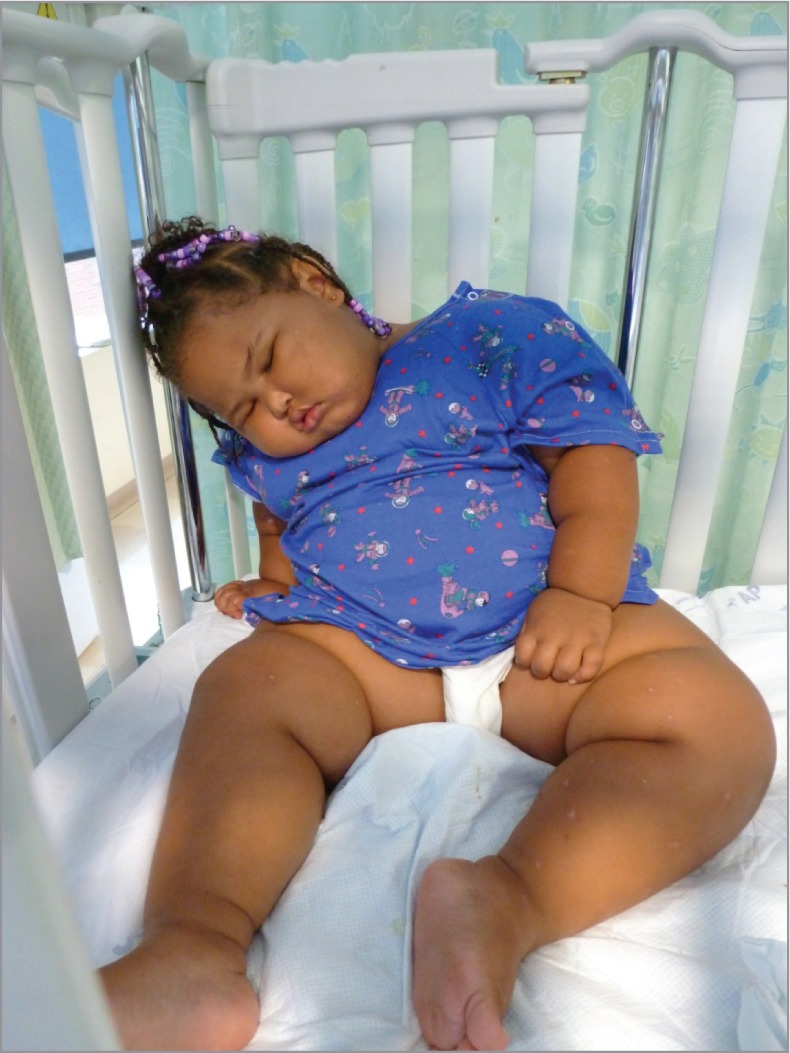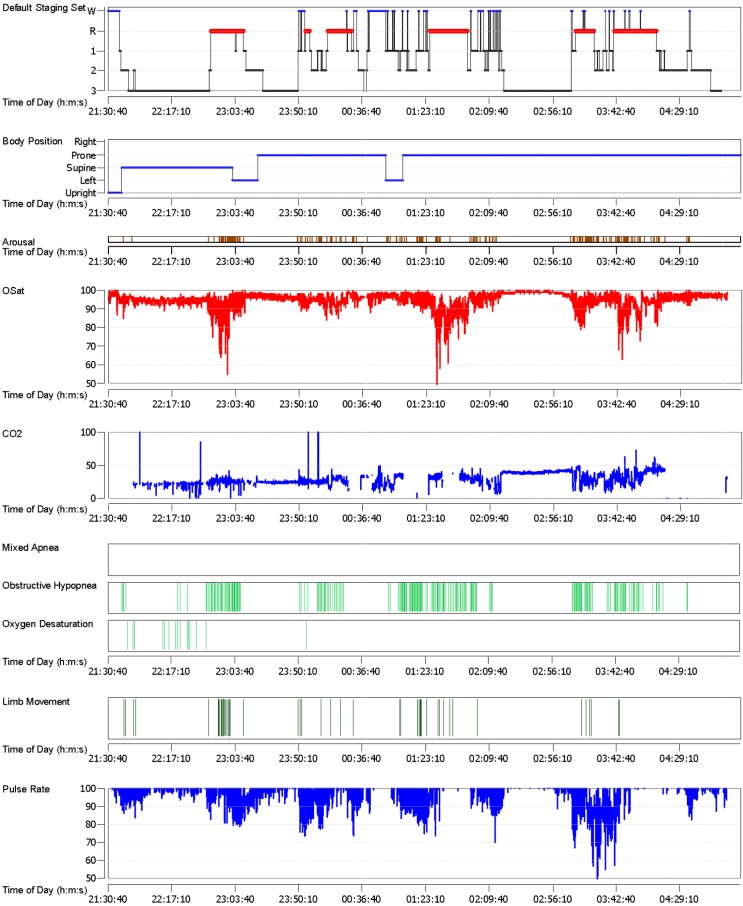Abstract
Obstructive sleep apnea (OSA) is a highly prevalent medical condition in obese children and is associated with significant neurocognitive, cardiovascular and metabolic derangements. Monogenic forms of obesity resulting from disruption of the leptin-melanocortin pathways have become more notable in recent years and distinguish between various obese phenotypes. However, the association of such disorders with OSA is not well established in children or adults. In this report, we describe a 23-month-old female with morbid obesity and OSA, who was found to carry a defect in the melanocortin-4 receptor (MC4R) pathway. This report emphasizes the genetic basis of obesity related to MC4R deficiency and OSA in children.
Citation:
Pillai S; Nandalike K; Kogelman Y; Muzumdar R; Balk SJ; Arens R. Severe obstructive sleep apnea in a child with melanocortin-4 receptor deficiency. J Clin Sleep Med 2014;10(1):99-101.
Keywords: Melanocortin 4 receptor (MC4R) deficiency, monogenic obesity, OSA, polysomnography
Monogenic forms of obesity could result from disruptions of the leptin-melanocortin pathway. The most common causes are those associated with mutations in the melanocortin-4 receptor (MC4R). These are found in 2.5% of children with early onset obesity and in 6% of obese adults.1 The MC4R is expressed largely in the hypothalamus and closely involved in appetite regulation, autonomic and endocrine functions, and insulin resistance.
Obstructive sleep apnea (OSA) is one of the most deleterious consequences of childhood obesity and carries significant cardiovascular, neurocognitive, and metabolic morbidities. However, the association of MC4R deficiency and OSA in children is not well established, and may possibly affect a significant number of children with obesity in our society.
REPORT OF CASE
A 23-month-old obese Hispanic female presented to the Sleep Disorders Center at The Children's Hospital at Montefiore in April 2012 for evaluation of OSA. She was born at term weighing 2.7 kg (10th centile) to non-consanguineous parents. At 4 months, she was noted to have excessive appetite. At 6 months her weight was 13.6 kg (>> 97th centile), and by 13 months she weighed 28 kg (>> 97th centile). Other diagnoses included: asthma, chronic rhino-sinusitis, anemia, hypertension (treated with amlodipine), and mild pulmonary hypertension. Developmental milestones were appropriate for age.
Family history was significant for obesity in her siblings, parents, uncles and grandparents. In addition, there was a strong family history of diabetes mellitus, hypertension, stroke, and early deaths secondary to cardiovascular disease.
On examination her vital signs were normal. Her weight was 37 kg and height was 94 cm with a BMI of 41.8 and BMI Z-score of 7.1 (Figure 1). She was noted to have noisy, heavy breathing when awake, with 2+/4 tonsils and a crowded oropharynx. Laboratory tests were significant for HbA1C of 5.7% (normal = 4.7-6.4), elevated triglycerides 190 mg/dL (normal = 35-110) and elevated fasting insulin of 169 IU/mL (normal = 2.7-24.9). Thyroid profile and cortisol levels were normal. Leptin levels were high (47 ng/mL (normal = 27-30]), ruling out leptin deficiency. DNA sequencing for genes involved in early onset obesity (Athena Laboratories) showed homozygous mutations of the MC4R gene within codon 299 (Pro299his). Notably, there were no mutations in the leptin receptor gene. Overnight polysomnography was significant for severe OSA with an apnea-hypopnea index of 36 events/h and oxygen saturation nadir of 50% (Figure 2). Lateral neck x-ray confirmed enlarged adenoid and tonsils. Subsequently, she underwent adenotonsillectomy; however, she required noninvasive ventilation of 6 cm H2O to control residual symptoms of OSA.
Figure 1. Subject propped up in sleeping position prior to adentonsillectomy due to severe OSA in supine posture.

Figure 2. Hypnogram of the overnight sleep study demonstrating severe REM (red horizontal bars) related obstructive events (green vertical lines) with severe desaturations to 60% (red line).
DISCUSSION
To our knowledge this is the first report of OSA confirmed by polysomnography in a child or an adult identified to be homozygous for MC4R deficiency. We did find a single report in the form of “letter to the editor” describing anesthetic management of a child with MC4R deficiency undergoing adenotonsillectomy.2 Considering the prevalence of MC4R gene mutations, it is possible that the association with OSA is under reported, especially since genetic testing for MC4R is seldom performed in these patients.
The association between early onset obesity and mutations in the MC4R gene was first described in 1998.3 The prevalence of MC4R deficiency in the general population is high and is estimated to be 1:2000.1 Homozygous individuals develop early onset symptoms that include: hyperphagia, morbid obesity, tall stature, increased lean body mass, and hyperinsulinemia.1 History of consanguinity increases the risk of homozygous MC4R mutations, and the earlier reports of MC4R deficiency are mostly from consanguineous parents.
Obesity increases the risk of OSA in children by more than fourfold.4 Previous studies have reported a 12% increase in severity of OSA for every unit increase in BMI above the mean for age and gender.5 Though it is likely that the morbid obesity in our patient contributed to the severity of the OSA, what is not clear is the role (if any) of melanocortin in the pathogenesis of OSA. It has been postulated that high leptin levels may serve as an adaptive mechanism to provide ventilatory stimulation that is suppressed in obese individuals.6 The high insulin levels in the patient in discussion could have resulted from a combination of morbid obesity, severe OSA,7 and mutation of MC4R pathway.8
A recent study reports a high prevalence of ADHD in subjects with MC4R deficiency.9 Obesity and ADHD are highly heritable conditions, possibly sharing a common link involving the dopamine receptor. Even though the mechanisms of association between MC4R related obesity and ADHD are unclear it could very well be related to underlying, untreated OSA.
Currently, there are no specific treatment guidelines for MC4R deficiency other than weight management, exercise, and lifestyle modifications. In addition, we treated our patient with adentonsillectomy and noninvasive ventilation during sleep to address the important morbidities associated with OSA.
In summary, this report emphasizes that early obesity may not only be linked to OSA but could suggest a specific mutation in the MC4R gene. With the growing epidemic of obesity, it is important that pediatricians and sleep physicians be aware of this genetic disorder. Finally, future research may provide more information on the possible links between MC4R and OSA.
DISCLOSURE STATEMENT
This was not an industry supported study. Funding: National Institutes of Health grants: HD-053693 and HL-105212. The authors have indicated no financial conflicts of interest.
REFERENCES
- 1.Farooqi IS, O'Rahilly S. Monogenic obesity in humans. Annu Rev Med. 2005;56:443–58. doi: 10.1146/annurev.med.56.062904.144924. [DOI] [PubMed] [Google Scholar]
- 2.Pratap JN, Sekhri C, Lloyd-Thomas AR. Anesthetic management for adenotonsillectomy of a child with severe obesity due to homozygous melanocortin-4 receptor gene mutations. Paediatr Anaesth. 2009;19:195–6. doi: 10.1111/j.1460-9592.2008.02923.x. [DOI] [PubMed] [Google Scholar]
- 3.Vaisse C, Clement K, Guy-Grand B, Froguel P. A frameshift mutation in human MC4R is associated with a dominant form of obesity. Nat Genet. 1998;20:113–4. doi: 10.1038/2407. [DOI] [PubMed] [Google Scholar]
- 4.Redline S, Tishler PV, Schluchter M, Aylor J, Clark K, Graham G. Risk factors for sleep-disordered breathing in children. Associations with obesity, race, and respiratory problems. Am J Respir Crit Care Med. 1999;159:1527–32. doi: 10.1164/ajrccm.159.5.9809079. [DOI] [PubMed] [Google Scholar]
- 5.Tauman R, Gozal D. Obstructive sleep apnea syndrome in children. Expert Rev Respir Med. 2011;5:425–40. doi: 10.1586/ers.11.7. [DOI] [PubMed] [Google Scholar]
- 6.O'Donnell CP, Schaub CD, Haines AS, et al. Leptin prevents respiratory depression in obesity. Am J Respir Crit Care Med. 1999;159:1477–84. doi: 10.1164/ajrccm.159.5.9809025. [DOI] [PubMed] [Google Scholar]
- 7.de la Eva RC, Baur LA, Donaghue KC, Waters KA. Metabolic correlates with obstructive sleep apnea in obese subjects. J Pediatr. 2002;140:654–9. doi: 10.1067/mpd.2002.123765. [DOI] [PubMed] [Google Scholar]
- 8.Saeed S, Butt TA, Anwer M, Arslan M, Froguel P. High prevalence of leptin and melanocortin-4 receptor gene mutations in children with severe obesity from Pakistani consanguineous families. Mol Gen Metab. 2012;106:121–6. doi: 10.1016/j.ymgme.2012.03.001. [DOI] [PubMed] [Google Scholar]
- 9.Agranat-Meged A, Ghanadri Y, Eisenberg I, Ben Neriah Z, Kieselstein-Gross E, Mitrani-Rosenbaum S. Attention deficit hyperactivity disorder in obese melanocortin-4-receptor (MC4R) deficient subjects: a newly described expression of MC4R deficiency. Am J Med Genet B Neuropsychiatr Genet. 2008;147B:1547–53. doi: 10.1002/ajmg.b.30842. [DOI] [PubMed] [Google Scholar]



